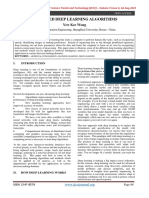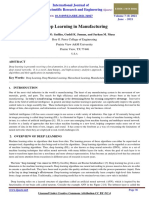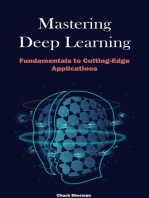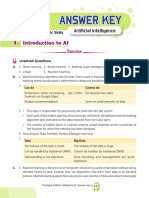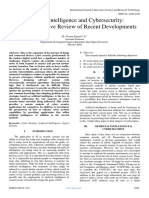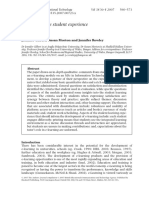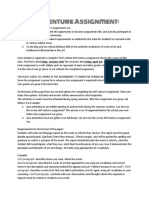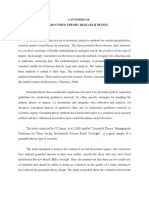Professional Documents
Culture Documents
Deep Learning Approaches in Cyber Security-A Comprehensive Survey
Copyright
Available Formats
Share this document
Did you find this document useful?
Is this content inappropriate?
Report this DocumentCopyright:
Available Formats
Deep Learning Approaches in Cyber Security-A Comprehensive Survey
Copyright:
Available Formats
Volume 7, Issue 9, September – 2022 International Journal of Innovative Science and Research Technology
ISSN No:-2456-2165
Deep Learning Approaches in Cyber
Security-A Comprehensive Survey
1
V. Jayabharathi, 2Dr. S. Sukumaran
1
Ph.D Research Scholar, 2Associate Professor
1
Excel College for commerce and science, komarapalayam-638183, Tamilnadu, India
2
Erode Arts and Science College (Autonomous), Erode-638009, Tamilnadu, India
Abstract:- Recent years have seen the successful Machine Learning- In the middle of the 1950s,
application of deep learning techniques, an enhanced machine learning was developed to generate artificial
model of conventional machine learning, in a variety of intelligence. Its emphasis shifted to developing programmes
fields, including banking, entertainment, coordinating, that were better than iteration but were created with a single
health care, and cyber security. The study concentrated objective in mind and could be broadly understood as a form
on a thorough examination of deep learning techniques in of function optimization. As the 20th century drew to an end,
cyber security. Adversarial attacks have emerged as a artificial intelligence ultimately started to evolve into its own
more significant security threat to many deep learning area, and machine learning started to develop into a more
applications than machine learning in the real world as advanced and mature science. Since numerous disciplines,
deep learning techniques have become the core including computer science and statistics, contribute to and
components for many security-critical applications such are inspired by machine learning, many statistics
as identity recognition cameras, malware detection programmes frequently incorporate and encourage their
software, intrusion detection, spam detection, and self- students to become proficient in the techniques. AI and
driving cars. Through a review of the literature and statistics are coupled with machine learning. [3, 5] Given that
consideration of the important research topics, this paper it combines AI heuristics with statistical analysis, it is an
gives a thorough study on the Deep Learning process, evolution of AI. Machine learning is to make it possible for
supervised, and unsupervised approaches. The survey computer systems to understand the data and make judgments
also discusses important DL architectures used in cyber based on its properties. As a result, it employs statistics for
security applications. fundamental ideas and promotes more AI heuristics to
achieve its goal. Supervised and unsupervised learning are
Keywords:- Deep learning, Cyber Security, Supervised the two main paradigms that make up machine learning. With
learning, and Unsupervised learning. contrast to unsupervised learning, in supervised learning we
already know what the label/response variable Y is. As a
I. INTRODUCTION result, we can efficiently assess a model's effectiveness. We
lack this knowledge in unsupervised learning, making it
For millennia, wise people had fantasised of creating a impossible for us to gauge how accurate we are. It makes
machine that could mimic human brain function. Since sense to talk about the history of this topic before examining
"associationism," a theory that required scientists to the difficulties with both paradigms [3, 4].
comprehend the workings of human recognition systems, was
first put forward by Aristotle in 300 B.C., it is possible to A. Deep Leaning
trace the roots of deep learning all the way back to that time. A subset of machine learning called "deep learning"
The McCulloch-Pitts (MCP) model, also referred to as the allows for highly computational models with numerous
Prototype of artificial neural networks, was first proposed in layers of abstraction. The state of the art in many fields,
1943, marking the beginning of the modern era of deep including the identification of illness treatments and
learning. Based on neural networks that functionally genomes, voice recognition, visual recognition, object
resemble the neocortex in human brains, they developed a finding, and many others, has been greatly enhanced by these
computer model. They used "threshold logic," a techniques. The primary characteristic of dl layers is that they
mathematical and algorithmic mix, in their model to simulate were learned from the data using a general-purpose learning
human reasoning, but not learning. Since then, deep learning technique rather than being created by humans. Deep learning
has continuously advanced, reaching a few major turning is making remarkable strides toward resolving issues that
points [1]. have long defied the best efforts of the AI community. In
addition to multiplying the registers in picture recognition, it
Artificial Intelligence - Artificial intelligence is the has shown to be particularly effective in detecting complex
study of creating computer systems that can simulate human structures in high dimensional data and is thus useful to many
intelligence. The terms "artificial" and "intelligence" make up fields of research, commerce, and government. [5].
this phrase.
IJISRT22SEP037 www.ijisrt.com 770
Volume 7, Issue 9, September – 2022 International Journal of Innovative Science and Research Technology
ISSN No:-2456-2165
The three categories of DL approaches include the underlying structure of data and representing it in a
supervised with labeled data, unsupervised without a label, compressed manner require grouping data based on
semi-supervised, and reinforcement learning, which similarities. Association rule mining and clustering are
combines partially labeled data with additional unlabeled examples of unsupervised algorithms. Algorithms: GAN,
data. AE, SOM, RBM, and DBN
Supervised learning: In order to train algorithms to Semi-supervised learning - This strategy falls
correctly recognize input or predict outcomes, it has labeled somewhere in the middle between supervised and
datasets. Supervised education the dataset is separated into unsupervised learning. Combining labeled and unlabeled
pieces for training, testing, and validation. The training data makes up training data. While there is a significant
dataset contains inputs as well as the desired outcomes. After amount of unlabeled data, there is a relatively little amount of
receiving the input data, the model adjusts its weights until annotated data. There needs to be a relationship between the
the error is properly reduced. Algorithms: Multilayer objects with assumptions in order to use the unlabeled
Perception, CNN, RNN, LSTM and GRU dataset.
Unsupervised learning: Unsupervised learning Algorithm: CNN+LSTM, GAN+CNN, DDL, DRL
techniques identify patterns from unlabeled [9] data. Finding
Fig 1:- Source: IBM Blog
B. Cyber Security significant issue of cyber security for upcoming ICT systems,
We are entering Industry 4.0 as a result of the rapid it is crucial to identify the gaps in the body of literature. [14]
development of cyber physical systems (CPS), which are With the aim of maintaining the confidentiality, integrity, and
driven by technologies like cloud computing, mobile accessibility of information in the cyberspace, the term
computing, edge computing, and the Internet of Things (IoT). "cyber security" has developed to refer to a collection of
However, as systems become more heterogeneous, principles and practices to safeguard ICT systems and
sophisticated, and networked, the importance of cyber networks. Cybercrime refers to illegal activities committed
security in CPS is also expanding due to the inherent security within the CPS that result in malicious attacks on computer
risks and vulnerabilities. In 2018, there were 13% more hardware, networks, and software. What's more, the dangers
vulnerabilities overall [10]. Zero-day exploits are expected to to data integrity from un authorized access, theft, disclosure,
increase from one per week in 2015 to one per day by 2021 and malicious or unintentional harm are becoming more
[12]. While the demand for cyber security specialists is rising significant. The broad threat categories have not changed
globally to address this issue, there is a scarcity of qualified over time, despite a rise in criminals and enemies in the field
researchers and practitioners, with that number potentially of cyber security. [15] The fundamental purpose of security
reaching 25% [13]. A survey that acts as a lesson for cyber research is to stop attackers from attaining their objectives,
security experts is required. To assist in solving the so it is crucial to have a thorough understanding of the many
IJISRT22SEP037 www.ijisrt.com 771
Volume 7, Issue 9, September – 2022 International Journal of Innovative Science and Research Technology
ISSN No:-2456-2165
forms of attacks. Numerous cyber security strategies, Based on their areas of operation, the following
including intrusion detection (ID), malware analysis, social categories of cyber security can be made.
network analysis, advanced persistent threats, online Network security: These cyber security technologies
application security, and applied cryptography are being used protect businesses' networks and communications against
to combat these dangers. An adaptive cyber security unauthorized access.
architecture that can proactively respond to changes in Applications and software are protected from any harmful
systems and physical processes is lacking, despite the activity that could result in data loss thanks to this cyber
massive rise of CPS towards Industry 4.0. The massive security protocol.
amounts of data collected by today's cyber security systems End-user security: This procedure keeps system users
from network sensors, logs, and endpoint agents can be informed so they may operate safely and stay safe from
processed effectively utilizing data mining (DM) techniques online risks.
to deliver timely information about harmful activity. By Operational security: Managing and moving huge
detecting network attacks, eliminating malware, finding amounts of data are typical requirements for business
vulnerabilities, and securing the system, deep learning operations. The organisations' continued operation
opened up new security perspectives. Deep learning depends heavily on its safety, which is provided by cyber
algorithms are able to identify more complex threats since security.
they are not dependent on memory of well-known cues and Informational security protects databases against
typical assault patterns. Instead, they become familiar with unauthorized users and hackers who might try to access
the system and can see strange activity that could be a sign of the data for their own or other people's financial gain.
malware or malicious actors. Disaster recovery and business continuity: This cyber
security practise was developed in response to a cyber-
Type of attackers security incident that would have resulted in data loss.
The knowledge of the attacker can be divided into three Therefore, these techniques guarantee that all lost data is
categories. In the "black box" model, the attacker is retrieved and that business operations return to normal.
completely unaware of the deep learning model and has no
prior knowledge of it. In the grey box model, the attackers Deep learning techniques are very successful at
have a basic understanding of the model and are aware of securing systems and data since they can carry out all the
information about certain of its components. In the white box tasks listed under cyber security [16]. The employment of
model, the attacker is fully aware of the model, and this these cutting-edge techniques in cyber security helps to
worst-case scenario is the only one that can occur.[15] protect data, systems, users, and organizations from harmful
attacks. Deep learning techniques are also very useful in the
field of cyber security due to their great accuracy and
efficiency as well as their capacity for autonomous
improvement.
Fig 2:- Types of Cyber Attacks
Source: Blog Sites
This covers insider threat identification, spam and architecture designs for cyber security have proliferated
phishing detection, malware and botnet detection, network recently. On the other hand, attackers are employing the same
traffic analysis, and intrusion detection, among other things. resources to carry out more complex attacks. Today's DL has
With the advancement of technology, cyber security data is made major advancements in traditional signature- and rule-
continuously expanding, and this growth has an impact on based systems as well as traditional machine learning-based
how well DL-based solutions work. Different DL solutions, and it can offer fresh perspectives on issues relating
IJISRT22SEP037 www.ijisrt.com 772
Volume 7, Issue 9, September – 2022 International Journal of Innovative Science and Research Technology
ISSN No:-2456-2165
to cyber security. It is difficult to make judgments regarding The impact of the maximising problem on social
the effectiveness of any certain technique because different networks was discussed by the author. The main goal is to
authors employed different datasets and measurements. identify a limited group of nodes that will maximise
However, there are certain broad tendencies that may be seen. influence. The issue of tackling the influence maximisation
So, across the many security areas, there was a noticeable problem utilising greedy algorithms and stochastic
variance in performance. With TPR ranging between 96.01% optimization techniques like simulated annealing has also
and 99.86%, FPR ranging between 1% and 1.95%, and been studied. A unique GA is utilised to enhance influence
accuracy ranging between 0.9959 and 0.9969, DL appears to while maintaining variety through the usage of many
have the most reliable performance among the domains using populations. The structure of modified GA is sometimes
several techniques. The performance of methods for impacted, ensuring the diversity of the possible options and
detecting network intrusions, however, showed broader elevating the complexity of the optimization procedure. In the
variations, with TPRs ranging from 92.33% to 100%, FPRs future, there might be a focus on how the makeup of a
from 1.58% to 2.3%, and accuracy from 44% to 99%. Due of particular population has changed and how those changes
the vast amounts of data and many sources present in the have affected its attributes. OSN [13]
cyber world, DL can be successfully used to the field of cyber
security. However, the lack of publicly accessible datasets is The author of [14] offered yet another set of attacks to
making this line of research increasingly challenging. These violate user privacy. This cutting-edge assault type takes
datasets are not shared among researchers and are small, advantage of advertising platforms with the ability to
outdated, or internally produced. To advance cyber security microtarget audiences. One of the biggest and most well-
systems, it will be essential to create sizable benchmark known online social network systems in the world, Facebook,
datasets that are consistently updated. Additionally, the had its advertising system as the author's primary focus.
capability to evaluate proposed DL algorithms in actual Information leakage across different advertising campaigns
operating scenarios is required for comparing detection rates, has been linked to a number of design decisions made by
speed, memory utilization, and other performance indicators. advertising systems. It has also been explained why
The significance of DL has already been recognized by the Facebook's remedies to the aforementioned vulnerabilities
cyber security sector, and as a result, new datasets are were insufficient to provide a defence. Nowadays, most
appearing. people use many social media accounts.
II. RELATED RESEARCH WORKS The degree of security and privacy offered by any
online network varies depending on the sort of service it
The most recent studies are geared toward readers who offers. The author, Shuochao Yao and Yiran Zhao et al.,
want to start researching deep learning (DL) for cyber discussed difficulties and recently developed solutions that
security. DL is a subset of machine learning; however it point to the viability of creating dependable, efficient, and
differs from traditional learning in that it is more recent and effective IoT systems that incorporate deep learning
complicated. As a result, emphasis is placed heavily on techniques [15].
providing a comprehensive overview of the DL approaches
and providing references to important works for each DL CNNs and RNNs were utilised by Kolosnjaji et al. [16]
method. Examples that show how the techniques have been to recognise malware. One-hot encoding is used to transform
applied in cyber security are also provided. Highly cited the list of call sequences to the API kernel into binary vectors.
papers were given extra attention because they describe A method for storing categorical data that makes it easier for
common procedures. Some less-cited publications were also machine learning is one-hot encoding. The DL algorithm,
picked because it was understood that this emphasis could which consists of a CNN and RNN, is trained using this data
ignore important new and emerging strategies. Overall, (consisting of an LSTM, and a softmax layer). This model
articles were chosen so that each of the DL categories given achieves 89.4% accuracy, 85.6% precision, and 89.4% recall.
below had at least one, but ideally several, representative
papers. This section goes into great detail about the approach LEMNA, a novel technique to develop high-fidelity
and limits of each paper. explanations for specific classification findings for security
applications, is introduced in this paper[17]. A target deep
Jianwensunetal[10]: This study suggests a Deep Belief learning model is treated as a "black box" by LEMNA, and
Network-based approach for automatic fault identification its decision boundary is approximated using a mixed
for quality in section of electro motors. Results produced by regression model improved by fused lasso. We demonstrate
the suggested strategy are quite precise. that the suggested strategy generates extremely accurate
explanations by testing it on two well-known deep learning-
Wei-longzhengetal [12]: In this study, two emotional based security applications. Additionally, we show how
categories based on EEG were classified using Deep Belief LEMNA may help security analysts and machine learning
Networks. When compared to alternative State-of-the-art developers better understand classifier behavior, fix
procedures, the suggested method produces findings that are misclassification issues, and even apply automated updates to
more precise. improve the initial deep learning model.
IJISRT22SEP037 www.ijisrt.com 773
Volume 7, Issue 9, September – 2022 International Journal of Innovative Science and Research Technology
ISSN No:-2456-2165
In many applications, feature sequence extraction and A Deep feed forward Neural Collaborative Filtering
data categorization using RNN and notably LSTM was suggested by Farhan Ullah et al. [22] for the selection of
demonstrate excellent efficiency. Recurrent networks have educational services. The benchmark excellent books 10k
the benefit of being able to process data sequences where a was used as the basis for the experiments in Keras.
lengthy pattern of multidimensional features is modelled to
place a specific sample in the proper class or map the entire Modern deep learning classification techniques were
sequence into a predicted scalar in regression issues. LSTM used by the author [2] in comparison to traditional machine
was shown to be effective in [18] for automatically extracting learning techniques. It constructed a corpus of cypher text for
features for highly accurate solar array defect diagnostics. a multilingual dataset with 700 files on average, each with
4000 characters, and used our methods on this generated
The author [19] studied if deep learning models may be cypher text. They employed the cyphers AES and Blowfish.
used for the security evaluation of cryptographic methods. In
order to run the trials utilising technique 1 against S-DES and As technology advances, the frequency and complexity
round reduced Speck32/64, a few neural network models of cyber-attacks are rising steadily today. Traditional cyber
have been constructed. The complete key space is utilised for security solutions are unable to detect sophisticated unknown
S-DES and put to the test using MLP and CNN models. attacks like zero-day attacks and new malware variants in
According to the results, CNN scored badly on this test, such a complicated technological environment. Cyber
although several MLP models outperformed a random guess. security systems have included ML techniques to address
The best model was accurate to within 0.2157. Compared to these issues, but they have had limited effectiveness in
a random guess, which has an accuracy of 0.0009, it is thwarting unexpected or unanticipated attacks. Meanwhile,
substantially superior. This suggests that a neural network DL methodologies enhance the learning process and show
model can identify the right key for S-DES encryption in part. promising outcomes in a variety of applications, including
In 1-round Speck, technique 1 for Speck functioned cyber security. The significant developments in software
admirably. However, when the key set nK is set to 2, 4, and engineering and the large production of training data are
10, experimental results show that it is difficult to extend crucial to the success of DL. In order to do this, a thorough
method 1 beyond 2-round Speck. Using MLP and LSTM examination of DL approaches is performed, taking into
models, we also used approach 2 against S-DES. MLP account all facets of cyber security, including intrusion
models have demonstrated comparatively greater detection, software attack detection, and privacy protection.
performance and have a higher likelihood of recovering the We examine the architecture of each of the works we have
random S-DES key than a random guess. However, LSTM studied, paying close attention to the DL method(s) applied,
models were unable to retrieve the S-DES random key. how it was implemented, the test data sets used, and the
outcomes obtained. We have, if feasible, compared the
To address privacy concerns about collected data used effectiveness of the various approaches. It is important to
for deep learning training, Ma et al. [21] offer unique privacy note that this was the most challenging portion because most
preservation deep learning model, called PDLM. The PDLM studies do not use the same dataset for model testing.
uploads the encrypted data to service providers after applying
deep learning on the data owners' encrypted data using The recent works on deep learning methods CCN,
multiple keys. The model is trained by service providers and MLP, RNN, AE, LSTM, and, GAN Deep learning multi feed
the cloud platform using multi-key encrypted data and a forward neural network, on the applications namely health
toolbox for privacy preservation calculations. care, self-driving cars, coordination, entertainment, and
finance and cyber security, Text classification, image
identification and some are implemented on heterogeneous
data. Although many research studies have been published on
attacks and the defense of the security and privacy of deep
learning, they are still fragmented
Author, Year Method Merits Demerits
Daniel S. Berman, Anna L. RNN, RBM, AUTO ENCODER Reduce risk. Performance varies for
Buczak *, Jeffrey S. Chavis and different authors.
Cherita L. Corbett, 2019
Jollanda Shara,2021 CNN, RNN,RBN, GAN, AUTO Accuracy and Performance vary for
ENCODER performance is high. different authors
Aarontuor,2017 RNN-TUNING Good potential insider threat only detect
LSTM
Yue-JieHou,aZai-XinXie,a Jian- CONVOLUTIONAL High Accuracy, It Also Have Incomplete
Hu,a,1 Yao-Shen,b,2 and Chi- AUTOENCODER(CCAE)+HYBRID Robustness Structural Characteristic
Chun Zhoua,3,2021 CLUSTERING ALGORITHM
Tausiajansaleemmohammedahsan DNN LSTM Very good at Dl requires
chisth,2021 analyzing time series comprehensive labeled
data, data sets
IJISRT22SEP037 www.ijisrt.com 774
Volume 7, Issue 9, September – 2022 International Journal of Innovative Science and Research Technology
ISSN No:-2456-2165
Tolerate noise,
High accuracy
Miki banarjee,2018 NEURAL NETWORK More security Data’s are not
necessarily originated
from truth worth sources
Hardy et al,2016 CNN,AE,RBN More security Need lots of data set
Boosting knowledge
is highWide range of
networks
Tausiajansaleem, CNN,RNN,LSTM,AE,RBM,GAN More accurate High velocity, need
mohammedahsan chisth,2019 prediction and large data set
effective results
Benchea and Gavrilu¸t,2017 DCAE,HAC Reduce high It pass number of
dimensional requisite test
information data
Kwon et al. 2017 CNN+CLOUDNET Great accuracy Some classification
High performance occurs.
Efficient robustness
Su et al.2018 AE, DAC High accuracy Need large data set
Table 1:- Summary of Related works
This work focus on specific environments or applications, Cloud, IoT, Cyber-Physical Systems (CPS), social networks,
biometric and cryptography.
Authors Database Methods Result
s
Alaa S. Al-Waisy, Rami Qahwaji,StanleyIpson, Shumoos Al- SDUMLA- CNN( IRIS) 99.82
Fahdawi & Tarek A. M. Nagem,2018 CASIA-,IRIS-
V3
INTERVAL
AND IITD
HMT
LukeEverson,Dwaipayanbiswas,Madhuripanwar,2018 TROIKA CNN+LSTM 96%.
Fabula AI ,USI Lugano, Imperial College,2019 YOUTUBE GDL 92.7%
VIDEO
DATASET
Georgegkotsis1, Anikaoellrich1, Sumithravelupillai1,2, Maria Liakata3, FF 70.82%
Tim J. P. Hubbard4, Richard J. B. Dobson1,5 &Rina Dutta1,2017 REDDIT CNN 71.37%
LINEAR 58.72%
SVM 64.02%
Owusu-AgyemangKwabena, Zhen Qin , TianmingZhuang, And DATA SET DNN+HOMOMORPHI 93.42
Zhiguang Qin,2019 C ENCRYPTION
Yanshengli weichen yongjunzhangachaotaobruixiaoayihuatanc,2020
a a
DATA SET 1(WDCD) 96.66
2. GCP
3. CAM
4. LPP
MohamedEsmailkarar abfahadalsunaydiasultanalbusaymiasultanalotaibi,2 DATA SET R-CNN 99.0%
012
Alaa S. Al-WaisyRami Qahwaji, Stanley Ipson, SDUMLA- CNN( IRIS) 99.82
Shumoosal-Ahdawi & Tarek A. M. Nagem,2018 CASIA-,IRIS-
V3
INTERVAL
AND IITD
HMT
IJISRT22SEP037 www.ijisrt.com 775
Volume 7, Issue 9, September – 2022 International Journal of Innovative Science and Research Technology
ISSN No:-2456-2165
Giovanni Apruzzese,2018 DATA SET SUPERVISED AND Both
UNSUPRVISED Are
(ML+DL) Have
ALGORITHM Pros
&Cons
Zhiqiang Wang , 1,2,3 Gefei Li , 2 Zihanzhuo , 4 Xiaoruiren , 1 Yuheng KITHUB.CO CNN 99.353
Lin , 1 And Jieminggu 4,2021 M 8
Table 2:- Comparison of Various Deep Learning Methods in Cyber Security.
III. CONCLUSION Steganography And Cyber Security View Project
Conference Paper - June 2021 Citations 0 Reads 328
It is crucial to comprehend the importance of the data [6]. Daniel S. Berman, Anna L. Buczak, Jeffrey S. Chavis
provided on any social media platform in the age of the And Cherita L. Corbett Johns “A Survey Of Deep
internet and how to keep it safe and secure. Many privacy Learning Methods For Cyber Security” Hopkins
settings and policies in the literature are offered by service University Applied Physics Laboratory (JHU/APL1),
providers as well as created by researchers. It is necessary to Laurel, MD 20910, USA;
compare the current models in order to adopt ones that are [7]. Tausifa Jan Saleem, Mohammad ahsanchisht, “Deep
more reliable and secure, along with the creation of new Learning For Internet Of Things Data Analytics” -2019
models and procedures. Attacks on cyber networks continue Pp381-389
to develop at a rate that exceeds the capacity of cyber [8]. Tausifa Jan Saleem, Mohammad ahsanchisht, “Deep
defenders to create and implement new signatures to stop Learning For Internet Of Things Data Analytics”- 2021,
these new attacks. The application of DL approaches to a Pp526-542
wide range of these cyber security threat types that attacked [9]. Online Social Network Security: “A Comparative
networks, application software, host systems, and data was Review Using Machine Learning and Deep Learning”
described in this survey report. Additionally, it gave a (2021) 53:843–861
thorough analysis of the ways that DL techniques have been [10]. Chanchal Kumar, Taran Singh Bharati, Shiv Prakash
used to identify these cyber-attacks in the past. Describe the Online Social Network Security: “A Comparative
various criteria employed to assess DL performance for Review Using Machine Learning And Deep Learning”
applications related to cyber security. However, a fair 2021 PP 843-861
comparison between all of the various methodologies was not [11]. Mohaisen A, Alrawi O, Mohaisen M AMAL: High-
possible due to the use of various datasets for training and Fdelity, "Behavior-Based Automated Malware
testing. As a result, benchmark datasets are essential for Analysis And Classification". Computer Secure -
developing DL in the field of cyber security. 201552:251–266
[12]. Savage D, Zhang X, Yu X, Chou P, Wang Q “Anomaly
REFERENCES Detection In Online Social Networks”. Social Network-
2014 39:62–70
[1]. Yue-JieHou, Zai-XinXie, Jian-Hu, Yao-Shen, And [13]. LEMNA: Explaining Deep Learning Based Security
Chi-Chun Zhoua, “An Unsupervised Deep- Learning Applications,2018
Method For Fingerprint Classification”, The CCAE [14]. "Deep learning through LSTM classification and
Network And The Hybrid Clustering Strategy”-2019 . regression for transmission line fault detection,
[2]. Amine Boulemtafes, Abdelouahid Derhab, Yacine diagnosis and location in large-scale multi-machine
Challal,“A Review of Privacy-Preserving Techniques power systems",2021
For Deep Learning”. [15]. A.Y. Appiah, X. Zhang, B.B.K. Ayawli, F. Kyeremeh,
[3]. Techniques Muhammad Imran Tariq, Nisar Ahmed "Long Short-Term Memory Networks Based
Memon, Shakeel Ahmed, Shahzadi Tayyaba, Automatic Feature Extraction for Photovoltaic Array
Muhammad Tahir Mushtaq,Natash Ali Mian, Fault Diagnosis", IEEE Access 7 (2019) 30089–
Muhammad Imran. “A Review Of Deep Learning 30101,https://doi.org/10.1109/ACCESS.2019.2902949
Security And Privacy Defensive ”.-2018 .
[4]. Aaron Tuor and Samuel Kaplan And Brian Hutchinson [16]. McDermott, C.D.Majdani, F.Petrovski, "Botnet
Western Washington University Bellingham, WA detection in the internet of things using deep learning
Nicole Nichols And Sean Robinson Pacific Northwest approaches". In Proceedings of the 2018 International
National Laboratory Seattle, “Deep Learning for Joint Conference on Neural Networks (IJCNN), Rio de
Unsupervised Insider Threat Detection in Structured Janeiro, Brazil, 8–13 July 2018; pp. 1–8.
Cyber Security Data Streams” -2017 [17]. G. D. Hill and J. A. Bellekens, "Deep learning based
[5]. Jollanda Shara, "Deep Learning Methods For Cyber cryptographic primitive classification", ArXiv,
security" Some Of The Authors Of This Publication September 2017, pp. 1-9.
Are Also Working On These Related Projects:
Application Aspects Of Ml And Dl In Cryptography,
IJISRT22SEP037 www.ijisrt.com 776
Volume 7, Issue 9, September – 2022 International Journal of Innovative Science and Research Technology
ISSN No:-2456-2165
[18]. T. Kim, B. Kang, M. Rho, S. Sezer and E. GyuIm, "A
multimodal deep learning method for Android malware
detection using various features", IEEE Transactions on
Information Forensics and Security, vol. 14, no. 3,
March 2019, pp. 773-788
[19]. Q. Feng, Y. Zhang, C. Li, Z. Dou and J. Wang,
"Anomaly detection of spectrum in wireless
communication via deep auto-encoders", The Journal
of Supercomputing, vol. 73, no. 7, July 2017, pp. 3161-
3178.
[20]. SourceFire, Inc., "Snort: An open source network
intrusion detection and prevention system". [Online]
Available: http://www.snort.org. Accessed on: Feb. 2,
2021.
[21]. AbdelBassetM,HawashH,ChakraborttyRK,RyanM, " A
Deep learning approach for smart energy management
in IoT-based smart cities ". IEEE Internet of Things
J.2021.
[22]. "A Review on Security Threats and Vulnerabilities in
Cloud Computing". International Journal of
Engineering Research & Technology (IJERT) ISSN:
2278-0181 IJERTV4IS070073 www.ijert.org Vol. 4
Issue 07, July-2015
IJISRT22SEP037 www.ijisrt.com 777
You might also like
- (IJCST-V9I4P17) :yew Kee WongDocument4 pages(IJCST-V9I4P17) :yew Kee WongEighthSenseGroupNo ratings yet
- A Review On Application of Deep Learning in Cyber ForensicsDocument4 pagesA Review On Application of Deep Learning in Cyber ForensicsIJRASETPublicationsNo ratings yet
- (IJIT-V7I5P1) :yew Kee WongDocument5 pages(IJIT-V7I5P1) :yew Kee WongIJITJournalsNo ratings yet
- A Study On Deep LearningDocument6 pagesA Study On Deep LearningIJRASETPublicationsNo ratings yet
- Artificial Intelligence Applications in Cybersecurity: 3. Research QuestionsDocument5 pagesArtificial Intelligence Applications in Cybersecurity: 3. Research Questionsjiya singhNo ratings yet
- Secure Identification at Your Fingertips Building A Face Recognition System With Google ColabDocument7 pagesSecure Identification at Your Fingertips Building A Face Recognition System With Google ColabIJRASETPublicationsNo ratings yet
- Machine Learning Approaches and Their BenefitsDocument6 pagesMachine Learning Approaches and Their BenefitsManoj KumarReddy100% (1)
- Differential Privacy Preserving Using TensorFlow DP-SGD and 2D-CNN For Large-Scale Image DataDocument9 pagesDifferential Privacy Preserving Using TensorFlow DP-SGD and 2D-CNN For Large-Scale Image DataIJRASETPublicationsNo ratings yet
- (IJETA-V9I1P1) :yew Kee WongDocument7 pages(IJETA-V9I1P1) :yew Kee WongIJETA - EighthSenseGroupNo ratings yet
- 1 s2.0 S0925231223010202 MainDocument18 pages1 s2.0 S0925231223010202 MainDr. V. Padmavathi Associate ProfessorNo ratings yet
- Jshara Icsns Viii CryptomlDocument10 pagesJshara Icsns Viii CryptomlBahr SimoNo ratings yet
- Cyber Security Meets Artificial inDocument13 pagesCyber Security Meets Artificial inKumar KumarNo ratings yet
- A Review of Grey Scale Normalization in Machine Learning and Artificial Intelligence For Bioinformatics Using Convolution Neural NetworksDocument7 pagesA Review of Grey Scale Normalization in Machine Learning and Artificial Intelligence For Bioinformatics Using Convolution Neural NetworksIJRASETPublicationsNo ratings yet
- Artificial Intelligence Student Management Based On Embedded SystemDocument7 pagesArtificial Intelligence Student Management Based On Embedded SystemAfieq AmranNo ratings yet
- Deep LearningDocument5 pagesDeep Learningcronysa0% (1)
- Data Hiding With Deep Learning A Survey Unifying Digital Watermarking and SteganographyDocument15 pagesData Hiding With Deep Learning A Survey Unifying Digital Watermarking and Steganographyfebaxag385No ratings yet
- Deep Learning Survey Highlights Methods and Wide ApplicationsDocument11 pagesDeep Learning Survey Highlights Methods and Wide ApplicationsVaradNo ratings yet
- Deep LearningDocument5 pagesDeep LearningNKOEBE KHOELINo ratings yet
- Deep Learning Algorithms For Intrusion DDocument8 pagesDeep Learning Algorithms For Intrusion Dgholamalinejad69No ratings yet
- Beyond Binary Exploring the Depths of Artificial Intelligence: programming, #2From EverandBeyond Binary Exploring the Depths of Artificial Intelligence: programming, #2No ratings yet
- I NGLESDocument12 pagesI NGLESMendoza Hernández OmarNo ratings yet
- Artificial Intelligence in Information and Cyber SecurityDocument8 pagesArtificial Intelligence in Information and Cyber SecurityMini MNo ratings yet
- Machine Learning and Deep Learning TechnDocument9 pagesMachine Learning and Deep Learning TechnAndyBarredaMoscosoNo ratings yet
- (IJIT-V7I6P2) :yew Kee WongDocument7 pages(IJIT-V7I6P2) :yew Kee WongIJITJournalsNo ratings yet
- Deep Learning: A Review: By-P.Thulasi PrasadDocument6 pagesDeep Learning: A Review: By-P.Thulasi PrasadThulasi PrasadNo ratings yet
- AI, ML, DL and Data ScienceDocument13 pagesAI, ML, DL and Data ScienceSujitNo ratings yet
- Predictive Maintenance using Machine Learning in Industrial IoTDocument7 pagesPredictive Maintenance using Machine Learning in Industrial IoTInternational Journal of Innovative Science and Research TechnologyNo ratings yet
- Deep Learning in ManufacturingDocument6 pagesDeep Learning in ManufacturingEditor IjasreNo ratings yet
- Artificial Intelligence For Cybersecurity - PaperDocument21 pagesArtificial Intelligence For Cybersecurity - PaperMarco Antonio WilmotNo ratings yet
- Ieee Cyber Security Using AiDocument4 pagesIeee Cyber Security Using AiSandeep SutradharNo ratings yet
- Deep Learning in EducationDocument6 pagesDeep Learning in Educationozypics6858No ratings yet
- A Detailed Excursion On Machine Learning Approach, Algorithms and ApplicationsDocument8 pagesA Detailed Excursion On Machine Learning Approach, Algorithms and Applicationsviju001No ratings yet
- Literature Review of Moving Object Detection Using Machine LearningDocument8 pagesLiterature Review of Moving Object Detection Using Machine LearningIJRASETPublicationsNo ratings yet
- 1 s2.0 S2772528621000352 MainDocument9 pages1 s2.0 S2772528621000352 MainAdamu AhmadNo ratings yet
- Deep Learning - Its Application and Importance: Niloj Mukhopadhyay January, 2021Document25 pagesDeep Learning - Its Application and Importance: Niloj Mukhopadhyay January, 2021Niloj MukhopadhyayNo ratings yet
- Artificial Intelligence Trendsand ChallengesDocument7 pagesArtificial Intelligence Trendsand ChallengesMohammad Al RaujiNo ratings yet
- A Survey On Building An Effective Intrusion Detection System (IDS) Using Machine Learning Techniques, Challenges and DatasetsDocument8 pagesA Survey On Building An Effective Intrusion Detection System (IDS) Using Machine Learning Techniques, Challenges and DatasetsIJRASETPublicationsNo ratings yet
- A Survey On Deep Learning: Algorithms, Techniques, and ApplicationsDocument36 pagesA Survey On Deep Learning: Algorithms, Techniques, and ApplicationsÀs MãNo ratings yet
- Report of Ann Cat3-DevDocument8 pagesReport of Ann Cat3-DevDev Ranjan RautNo ratings yet
- AI Overview: Applications, Advantages and ChallengesDocument4 pagesAI Overview: Applications, Advantages and ChallengesMohammed Shafeeq100% (1)
- (IJCST-V9I4P18) :yew Kee WongDocument5 pages(IJCST-V9I4P18) :yew Kee WongEighthSenseGroupNo ratings yet
- Class XI Unsolved Question&Answers (Part B-Unit-1 To 4)Document13 pagesClass XI Unsolved Question&Answers (Part B-Unit-1 To 4)Deep MakwanaNo ratings yet
- Deep BiometricsFrom EverandDeep BiometricsRichard JiangNo ratings yet
- A Survey of Machine Learning Algorithms For Big Data AnalyticsDocument4 pagesA Survey of Machine Learning Algorithms For Big Data Analyticspratiknavale1131No ratings yet
- Intrusion Detection Systems With Deep Learning: A Systematic Mapping StudyDocument5 pagesIntrusion Detection Systems With Deep Learning: A Systematic Mapping StudyYeseniaNo ratings yet
- FUNDAMENTALS OF ARTIFICIAL INTELLIGENCE AND DEEP LEARNING TECHNIQUES Ijariie12362 PDFDocument5 pagesFUNDAMENTALS OF ARTIFICIAL INTELLIGENCE AND DEEP LEARNING TECHNIQUES Ijariie12362 PDFJabeer Abdul SatharNo ratings yet
- Role of Machine Learning in MISDocument4 pagesRole of Machine Learning in MISMUNEEBA GULNo ratings yet
- BigdataDocument3 pagesBigdataVarunKaradesaiNo ratings yet
- Knowledge Will Propel Machine Understanding of Content: Extrapolating From Current ExamplesDocument17 pagesKnowledge Will Propel Machine Understanding of Content: Extrapolating From Current ExamplessanjrockzNo ratings yet
- Artificial Intelligence and Machine Learning As A Double-Edge Sword in Cyber WorldDocument5 pagesArtificial Intelligence and Machine Learning As A Double-Edge Sword in Cyber Worldarif arifNo ratings yet
- A S A I C: Urvey of Rtificial Ntelligence in YbersecurityDocument7 pagesA S A I C: Urvey of Rtificial Ntelligence in YbersecurityVinayNo ratings yet
- (IJIT-V7I5P2) :yew Kee WongDocument6 pages(IJIT-V7I5P2) :yew Kee WongIJITJournalsNo ratings yet
- (IJETA-V8I6P2) :yew Kee WongDocument5 pages(IJETA-V8I6P2) :yew Kee WongIJETA - EighthSenseGroupNo ratings yet
- Madda Walabu University: Collage of Computing Department of Information SystemDocument22 pagesMadda Walabu University: Collage of Computing Department of Information SystemLenchoNo ratings yet
- A Survey of Deep LearningDocument21 pagesA Survey of Deep LearningsdaffeNo ratings yet
- Big Data in The Machine Learning Techniques Perspective - A ReviewDocument8 pagesBig Data in The Machine Learning Techniques Perspective - A ReviewIJRASETPublicationsNo ratings yet
- Machine Learning and Deep Learning Approaches For CyberSecurity A ReviewDocument14 pagesMachine Learning and Deep Learning Approaches For CyberSecurity A ReviewManu ManviNo ratings yet
- Artificial Intelligence and Cybersecurity A Comprehensive Review of Recent DevelopmentsDocument4 pagesArtificial Intelligence and Cybersecurity A Comprehensive Review of Recent DevelopmentsInternational Journal of Innovative Science and Research TechnologyNo ratings yet
- An Analysis on Mental Health Issues among IndividualsDocument6 pagesAn Analysis on Mental Health Issues among IndividualsInternational Journal of Innovative Science and Research TechnologyNo ratings yet
- Harnessing Open Innovation for Translating Global Languages into Indian LanuagesDocument7 pagesHarnessing Open Innovation for Translating Global Languages into Indian LanuagesInternational Journal of Innovative Science and Research TechnologyNo ratings yet
- Diabetic Retinopathy Stage Detection Using CNN and Inception V3Document9 pagesDiabetic Retinopathy Stage Detection Using CNN and Inception V3International Journal of Innovative Science and Research TechnologyNo ratings yet
- Investigating Factors Influencing Employee Absenteeism: A Case Study of Secondary Schools in MuscatDocument16 pagesInvestigating Factors Influencing Employee Absenteeism: A Case Study of Secondary Schools in MuscatInternational Journal of Innovative Science and Research TechnologyNo ratings yet
- Exploring the Molecular Docking Interactions between the Polyherbal Formulation Ibadhychooranam and Human Aldose Reductase Enzyme as a Novel Approach for Investigating its Potential Efficacy in Management of CataractDocument7 pagesExploring the Molecular Docking Interactions between the Polyherbal Formulation Ibadhychooranam and Human Aldose Reductase Enzyme as a Novel Approach for Investigating its Potential Efficacy in Management of CataractInternational Journal of Innovative Science and Research TechnologyNo ratings yet
- The Making of Object Recognition Eyeglasses for the Visually Impaired using Image AIDocument6 pagesThe Making of Object Recognition Eyeglasses for the Visually Impaired using Image AIInternational Journal of Innovative Science and Research TechnologyNo ratings yet
- The Relationship between Teacher Reflective Practice and Students Engagement in the Public Elementary SchoolDocument31 pagesThe Relationship between Teacher Reflective Practice and Students Engagement in the Public Elementary SchoolInternational Journal of Innovative Science and Research TechnologyNo ratings yet
- Dense Wavelength Division Multiplexing (DWDM) in IT Networks: A Leap Beyond Synchronous Digital Hierarchy (SDH)Document2 pagesDense Wavelength Division Multiplexing (DWDM) in IT Networks: A Leap Beyond Synchronous Digital Hierarchy (SDH)International Journal of Innovative Science and Research TechnologyNo ratings yet
- Comparatively Design and Analyze Elevated Rectangular Water Reservoir with and without Bracing for Different Stagging HeightDocument4 pagesComparatively Design and Analyze Elevated Rectangular Water Reservoir with and without Bracing for Different Stagging HeightInternational Journal of Innovative Science and Research TechnologyNo ratings yet
- The Impact of Digital Marketing Dimensions on Customer SatisfactionDocument6 pagesThe Impact of Digital Marketing Dimensions on Customer SatisfactionInternational Journal of Innovative Science and Research TechnologyNo ratings yet
- Electro-Optics Properties of Intact Cocoa Beans based on Near Infrared TechnologyDocument7 pagesElectro-Optics Properties of Intact Cocoa Beans based on Near Infrared TechnologyInternational Journal of Innovative Science and Research TechnologyNo ratings yet
- Formulation and Evaluation of Poly Herbal Body ScrubDocument6 pagesFormulation and Evaluation of Poly Herbal Body ScrubInternational Journal of Innovative Science and Research TechnologyNo ratings yet
- Advancing Healthcare Predictions: Harnessing Machine Learning for Accurate Health Index PrognosisDocument8 pagesAdvancing Healthcare Predictions: Harnessing Machine Learning for Accurate Health Index PrognosisInternational Journal of Innovative Science and Research TechnologyNo ratings yet
- The Utilization of Date Palm (Phoenix dactylifera) Leaf Fiber as a Main Component in Making an Improvised Water FilterDocument11 pagesThe Utilization of Date Palm (Phoenix dactylifera) Leaf Fiber as a Main Component in Making an Improvised Water FilterInternational Journal of Innovative Science and Research TechnologyNo ratings yet
- Cyberbullying: Legal and Ethical Implications, Challenges and Opportunities for Policy DevelopmentDocument7 pagesCyberbullying: Legal and Ethical Implications, Challenges and Opportunities for Policy DevelopmentInternational Journal of Innovative Science and Research TechnologyNo ratings yet
- Auto Encoder Driven Hybrid Pipelines for Image Deblurring using NAFNETDocument6 pagesAuto Encoder Driven Hybrid Pipelines for Image Deblurring using NAFNETInternational Journal of Innovative Science and Research TechnologyNo ratings yet
- Terracing as an Old-Style Scheme of Soil Water Preservation in Djingliya-Mandara Mountains- CameroonDocument14 pagesTerracing as an Old-Style Scheme of Soil Water Preservation in Djingliya-Mandara Mountains- CameroonInternational Journal of Innovative Science and Research TechnologyNo ratings yet
- A Survey of the Plastic Waste used in Paving BlocksDocument4 pagesA Survey of the Plastic Waste used in Paving BlocksInternational Journal of Innovative Science and Research TechnologyNo ratings yet
- Hepatic Portovenous Gas in a Young MaleDocument2 pagesHepatic Portovenous Gas in a Young MaleInternational Journal of Innovative Science and Research TechnologyNo ratings yet
- Design, Development and Evaluation of Methi-Shikakai Herbal ShampooDocument8 pagesDesign, Development and Evaluation of Methi-Shikakai Herbal ShampooInternational Journal of Innovative Science and Research Technology100% (3)
- Explorning the Role of Machine Learning in Enhancing Cloud SecurityDocument5 pagesExplorning the Role of Machine Learning in Enhancing Cloud SecurityInternational Journal of Innovative Science and Research TechnologyNo ratings yet
- A Review: Pink Eye Outbreak in IndiaDocument3 pagesA Review: Pink Eye Outbreak in IndiaInternational Journal of Innovative Science and Research TechnologyNo ratings yet
- Automatic Power Factor ControllerDocument4 pagesAutomatic Power Factor ControllerInternational Journal of Innovative Science and Research TechnologyNo ratings yet
- Review of Biomechanics in Footwear Design and Development: An Exploration of Key Concepts and InnovationsDocument5 pagesReview of Biomechanics in Footwear Design and Development: An Exploration of Key Concepts and InnovationsInternational Journal of Innovative Science and Research TechnologyNo ratings yet
- Mobile Distractions among Adolescents: Impact on Learning in the Aftermath of COVID-19 in IndiaDocument2 pagesMobile Distractions among Adolescents: Impact on Learning in the Aftermath of COVID-19 in IndiaInternational Journal of Innovative Science and Research TechnologyNo ratings yet
- Studying the Situation and Proposing Some Basic Solutions to Improve Psychological Harmony Between Managerial Staff and Students of Medical Universities in Hanoi AreaDocument5 pagesStudying the Situation and Proposing Some Basic Solutions to Improve Psychological Harmony Between Managerial Staff and Students of Medical Universities in Hanoi AreaInternational Journal of Innovative Science and Research TechnologyNo ratings yet
- Navigating Digitalization: AHP Insights for SMEs' Strategic TransformationDocument11 pagesNavigating Digitalization: AHP Insights for SMEs' Strategic TransformationInternational Journal of Innovative Science and Research TechnologyNo ratings yet
- Drug Dosage Control System Using Reinforcement LearningDocument8 pagesDrug Dosage Control System Using Reinforcement LearningInternational Journal of Innovative Science and Research TechnologyNo ratings yet
- The Effect of Time Variables as Predictors of Senior Secondary School Students' Mathematical Performance Department of Mathematics Education Freetown PolytechnicDocument7 pagesThe Effect of Time Variables as Predictors of Senior Secondary School Students' Mathematical Performance Department of Mathematics Education Freetown PolytechnicInternational Journal of Innovative Science and Research TechnologyNo ratings yet
- Formation of New Technology in Automated Highway System in Peripheral HighwayDocument6 pagesFormation of New Technology in Automated Highway System in Peripheral HighwayInternational Journal of Innovative Science and Research TechnologyNo ratings yet
- Analysis of Algorithms + McconnellDocument3 pagesAnalysis of Algorithms + McconnellNDNUPortfolioNo ratings yet
- CV Romy Redeker 2016 DefinitiefDocument2 pagesCV Romy Redeker 2016 Definitiefapi-300762588No ratings yet
- Physics - Feynman's Path Integral in Quantum TheoryDocument10 pagesPhysics - Feynman's Path Integral in Quantum TheoryArturo Reyes VacaNo ratings yet
- English9 - Q1 - M3 - Lesson 2Document21 pagesEnglish9 - Q1 - M3 - Lesson 2Dee En MartinezNo ratings yet
- Travel Services CGDocument15 pagesTravel Services CGlea bendijoNo ratings yet
- Teaching Guide: Introduction To Philosophy of Human PersonDocument20 pagesTeaching Guide: Introduction To Philosophy of Human PersonClarence Ramos82% (39)
- Detailed Lesson Plan in MAPEH-8: II. Subject Matter and ReferencesDocument6 pagesDetailed Lesson Plan in MAPEH-8: II. Subject Matter and ReferencesClarin Guivencan Charlotte71% (14)
- Jennifer Solomon Continual Professional Development With Nurses in Grenada West Indies PDFDocument500 pagesJennifer Solomon Continual Professional Development With Nurses in Grenada West Indies PDFBen תפילהNo ratings yet
- Clinical Instructor HandbookDocument58 pagesClinical Instructor HandbooknbvillarazoNo ratings yet
- GUIDE - IB Internal Assessments For HL MATHDocument2 pagesGUIDE - IB Internal Assessments For HL MATHLinda FuNo ratings yet
- ArmDocument5 pagesArmMahrukh SaeedNo ratings yet
- Geography-Rubric-Webquest 1Document1 pageGeography-Rubric-Webquest 1api-502062430No ratings yet
- E-Learning: The Student Experience: Jennifer Gilbert, Susan Morton and Jennifer RowleyDocument14 pagesE-Learning: The Student Experience: Jennifer Gilbert, Susan Morton and Jennifer RowleyNurul Amira AmiruddinNo ratings yet
- English For The Alien Invasion SampleDocument6 pagesEnglish For The Alien Invasion SampleLindsay ClandfieldNo ratings yet
- Leticia Ramos-ShahaniDocument10 pagesLeticia Ramos-ShahaniiancedrickglinofriarejanoNo ratings yet
- Department of Education: Republic of The PhilippinesDocument3 pagesDepartment of Education: Republic of The PhilippinesBurning RoseNo ratings yet
- Comerțul Cu o ProblemăDocument2 pagesComerțul Cu o ProblemăLex SmithNo ratings yet
- Total Spanish Course: Learn Spanish With The Michel Thomas Method: Beginner Spanish Audio Course - Michel ThomasDocument5 pagesTotal Spanish Course: Learn Spanish With The Michel Thomas Method: Beginner Spanish Audio Course - Michel Thomasguhofyki0% (1)
- Pashto PhoneticsDocument159 pagesPashto PhoneticsAmjad NassirNo ratings yet
- Social SciencesDocument109 pagesSocial SciencesRAJESHNo ratings yet
- Artventure Assignment 3Document2 pagesArtventure Assignment 3api-481932849No ratings yet
- MPDFDocument4 pagesMPDFdrarunmmcNo ratings yet
- English 3 - Unit 1-Lesson 1Document28 pagesEnglish 3 - Unit 1-Lesson 1Wilmer ChristianNo ratings yet
- Department of Education: Melcs-Based Budget of LessonsDocument4 pagesDepartment of Education: Melcs-Based Budget of LessonsLeahNNa vetoricoNo ratings yet
- A Synopsis of Grounded Theory Research DesignDocument3 pagesA Synopsis of Grounded Theory Research DesignJosie PabloNo ratings yet
- Forms of Social Life, InteractionDocument27 pagesForms of Social Life, InteractionVidhi BansalNo ratings yet
- Brian Canuno - Decision Making ScenariosDocument3 pagesBrian Canuno - Decision Making ScenariosBrian TiangcoNo ratings yet
- NSTPDocument3 pagesNSTPGladys Rudio AnchetaNo ratings yet
- Lesson Plan 2 Digit MultiplicationDocument4 pagesLesson Plan 2 Digit Multiplicationapi-337975202No ratings yet
- Tesda Courses Offered in Cebu International AcademyDocument3 pagesTesda Courses Offered in Cebu International AcademyodesageNo ratings yet
